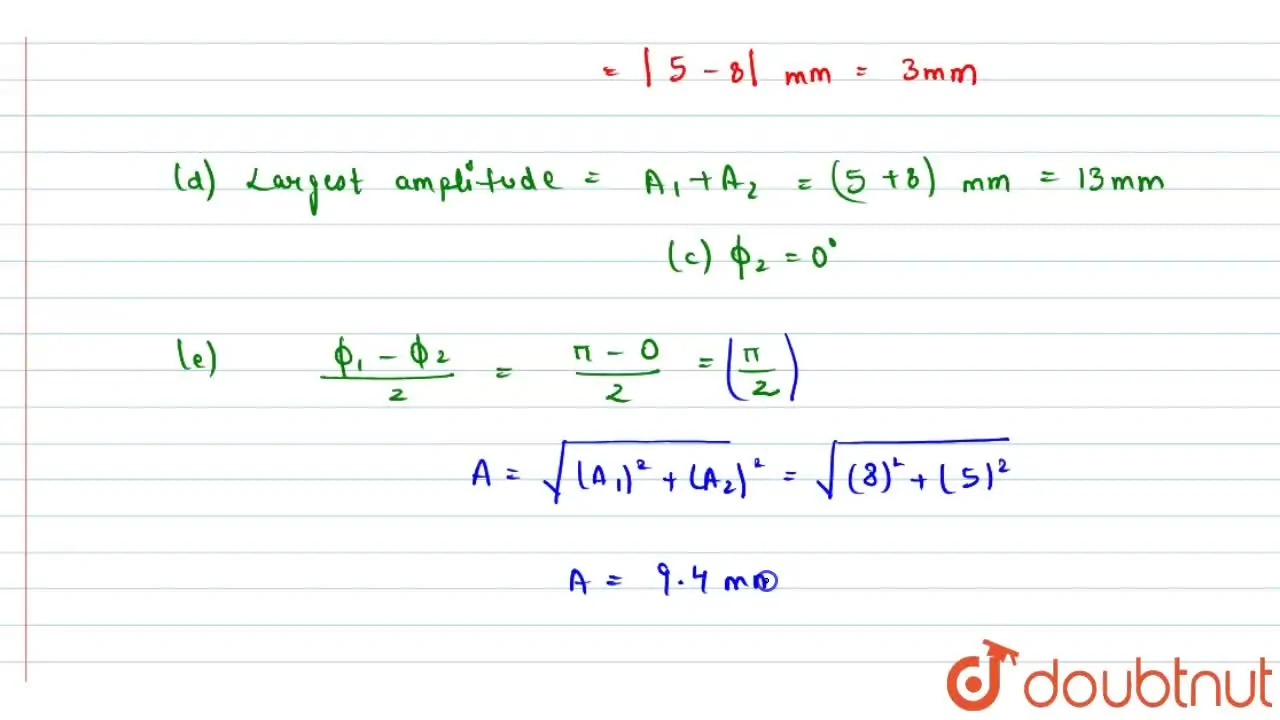Two sinusoidal wave of the same frequency are to be sent in the same direction along a taut string. One wave has an amplitude of 5.0mm, the other 8.0mm. (a) What phase difference ϕ1 between the two waves results in the smallest amplitude of the resultant wave? (b) What is that smallest amplitude? (c) What phase difference ϕ2 results in the largest amplitude of the resultant wave ? (d) What is that largest amplitude? (e) What is resultant amplitude if the phase angle is (ϕ1−ϕ2)/2?
The correct Answer is:(a) π rad; , (b) 3.0mm; , (c) 0 rad; , (d) 13mm; , (e) 9.4mm
(a) For smallest amplitude ,
AR=|A1−A2| and that is possible when ϕ1=π between A1 and A2
(b) AR=|A1−A2|=3mm
(c) For largest amplitude ,
AR=|A1+A2| and that is possible when ϕ2=0 between A1 and A2
(d) AR=|A1+A2|=13mm
(e) when ϕ=ϕ1−ϕ22=π−o2=π2
∴AR=[A12+A22+2A1A2cos(π)2]1/2
=9.4mm
Related Playlists
- BOOK - RESONANCE ENGLISHCHAPTER - WAVE ON STRING EXERCISE - Board Level Exercise27videos
WAVE ON STRING
- BOOK - RESONANCE ENGLISHCHAPTER - WAVE ON STRING EXERCISE - Exercise- 1 PART I23videos
WAVE ON STRING
- BOOK - RESONANCE ENGLISHCHAPTER - WAVE ON STRING EXERCISE - Exercise- 3 PART II7videos
WAVE ON STRING
- BOOK - RESONANCE ENGLISHCHAPTER - TRAVELLING WAVESEXERCISE - Exercise- 3 PART I19videos
TRAVELLING WAVES
- BOOK - RESONANCE ENGLISHCHAPTER - WAVE OPTICSEXERCISE - Advanced Level Problems8videos
WAVE OPTICS
Similar Questions
If the phase difference between the two wave is 2π during superposition, then the resultant amplitude is
View SolutionIf the phase difference between the two wave is 2π during superposition, then the resultant amplitude is
View SolutionCan two waves of the same frequency and amplitude travelling in the same direction give rise to a stationary wave after superposition ?
View SolutionTwo sine waves travel in the same direction in a medium. The amplitude of each wave is A and the phase difference between the two waves is 120∘. The resultant amplitude will be
View SolutionTwo identical sinusoidal waves each of amplitude 10 mm with a phase difference of 90∘ are travelling in the same direction in a string. The amplitude of the resultant wave is
View SolutionTwo waves, travelling in the same direction through the same region, have equal frequencies, wavelengths and amplitudes. If the amplitude of each wave is 4 mm and the phase difference between the waves is 90∘, what is the resultant amplitude ?
View SolutionTwo waves of same amplitude a and frequency v and having a phase difference of π/2 radian, are superposed. The amplitude of resultant wave is
View SolutionTwo sinusoidal waves of the same frequency travel in the same direction along a string. If A1=m3.0cm,A2=4.0cm,ϕ1=0, and ϕ2=π/2rad, what is the amplitude of the resultant wave ?
View SolutionTwo waves of equal amplitude when superposed, give a resultant wave having an amplitude equal to that of either wave. The phase difference between the two waves is
View SolutionTwo sinusoidal wave having the same frequency and travelling in the same direction are combined. What is the amplitude of the resultant motion if their amplitudes are 3cm and 4cm and they differ in phase by π/2 radian?
View Solution


